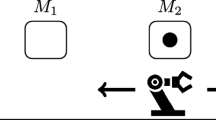Abstract
We study the scheduling of m-machine reentrant robotic cells, in which parts need to reenter machines several times before they are finished. The problem is to find the sequence of 1-unit robot move cycles and the part processing sequence which jointly minimize the cycle time or the makespan. When m = 2, we show that both the cycle time and the makespan minimization problems are polynomially solvable. When m = 3, we examine a special class of reentrant robotic cells with the cycle time objective. We show that in a three-machine loop-reentrant robotic cell, the part sequencing problem under three out of the four possible robot move cycles for producing one unit is strongly НП-hard. The part sequencing problem under the remaining robot move cycle can be solved easily. Finally, we prove that the general problem, without restriction to any robot move cycle, is also intractable.
Similar content being viewed by others
References
Aneja, Y. P. and H. Kamoun, “Scheduling of parts and robot activities in a two machine robotic cell” Computers and Operations Research, 26, 297–312 (1999).
Crama, Y. and J. van de Klundert, “Cyclic scheduling of identical parts in a robotic cell” Operations Research, 45, 952–965 (1997).
Crama, Y., V. Kats, J. van de Klundert, and E. Levner, “Cyclic scheduling in robotic flowshops” Annals of Operations Research, 96, 97–124 (2000).
Deineko, V. G., G. Steiner, and Z. Xue, “New solvable cases of the traveling salesman problem on permuted Monge matrices” Working Paper, School of Business, McMaster University, Canada, 2003.
Elliott, D. J., Integrated Circuit Fabrication Technology, 2nd ed. McGraw-Hill, New York, NY, 1989.
Garey, M. R. and D. S. Johnson, Computers and Intractability: A Guide to the Theory of NP-Completeness, W. H. Freeman, San Francisco, CA, 1979.
Gilmore, P. C. and R. E. Gomory, “Sequencing a one state-variable machine: A solvable case of the traveling salesman problem” Operations Research, 12, 655–679 (1964).
Graves, S. C., H. C. Meal, D. Stefek, and A. H. Zeghmi, “Scheduling of re-entrant flow shops” Journal of Operations Management, 3, 197–207 (1983).
Hall, N. G., H. Kamoun, and C. Sriskandarajah, “Scheduling in robotic cells: Classification, two and three machine cells” Operations Research, 45, 421–439 (1997).
Hall, N. G., H. Kamoun, and C. Sriskandarajah, “Scheduling in robotic cells: Complexity and steady state analysis” European Journal of Operational Research, 109, 43–65 (1998).
Hurink, J. and S. Knust, “Makespan minimization for flow-shop problems with transportation times and a single robot” Discrete Applied Mathematics, 112, 199–216 (2001).
Ioachim, I., E. Sanlaville, and M. Lefebvre, “The basic cyclic scheduling model for robotic flow shops” INFOR, 39, 257–277 (2001).
Kise, H., T. Shioyama, and T. Ibaraki, “Automated two-machine flowshop scheduling: A solvable case” IIE Transactions, 23, 10–16 (1991).
Kise, H., “On an automated two-machine flowshop scheduling problem with infinite buffer” Journal of the Operations Research Society of Japan, 34, 354–361 (1991).
Kubiak, W., S. X. C. Lou, and Y. Wang, “Mean flow time minimization in reentrant job shops with hub” Operations Research, 44, 764–776 (1996).
Lev, V. and I. Adiri, “V-shop scheduling” European Journal of Operational Research, 18, 51–56 (1984).
Levner, E. and V. Kats, “A parametric critical path problem and an application for cyclic scheduling” Discrete Applied Mathematics, 87, 149–158 (1998).
Levner, E., K. Kogan, and O. Maimon, “Flowshop scheduling of robotic cells with job-dependent transportation and set-up effects” Journal of the Operational Research Society, 46, 1447–1455 (1995).
Middendorf, M. and V. G. Timkovsky, “On scheduling cycle shops: Classification, complexity and approximation” Journal of Scheduling, 5, 135–169 (2002).
Noble, P. J. W., Printed Circuit Board Assembly: The Complete Works, Halsted Press, New York, NY, 1989.
Sethi, S. P., C. Sriskandarajah, G. Sorger, J. Blazewicz, and W. Kubiak, “Sequencing of parts and robot moves in a robotic cell” The International Journal of Flexible Manufacturing Systems, 4, 331–358 (1992).
Sriskandarajah, C., N. G. Hall, and H. Kamoun, “Scheduling large robotic cells without buffers” Annals of Operations Research, 76, 287–321 (1998).
Van de Klundert, J., Scheduling Problems in Automated Manufacturing, Ph.D. Thesis, University of Limburg, Maastricht, The Netherlands, 1996.
Wang, M. Y., S. P. Sethi, and S. L. van de Velde, “Minimizing makespan in a class of reentrant shops” Operations Research, 45, 702–712 (1997).
Author information
Authors and Affiliations
Corresponding author
Rights and permissions
About this article
Cite this article
Steiner, G., Xue, Z. Scheduling in Reentrant Robotic Cells: Algorithms and Complexity. J Sched 8, 25–48 (2005). https://doi.org/10.1007/s10951-005-5314-6
Issue Date:
DOI: https://doi.org/10.1007/s10951-005-5314-6




